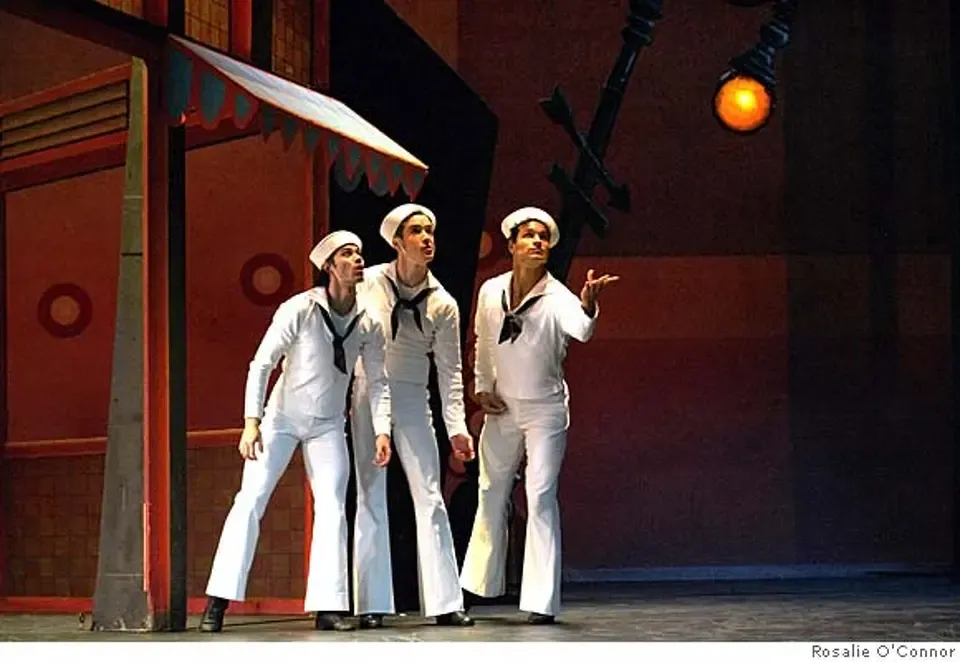Gala Program

“Ballo della Regina”, “Clear pas de deux”, “The Leaves are Fading pas de deux”, “Don Quixote pas de deux”, “Fancy Free”
American Ballet Theatre
New York City Center
New York, New York
October 23, 2007
The very brief gala program opened with the first performance by ABT of Balanchine’s sparkling exploration of female allegro, Ballo della Regina. It was staged by its originator Merrill Ashley, who got a curtain call and her own bouquet of flowers, in addition to the bouquet generously given to her by Gillian Murphy; a truly lovely gesture of gratitude and respect. And a well-deserved one, since the performance was beautifully rehearsed and, given the limitations of the smaller stage, exuberantly danced. The corps gave the charming, musical little accents the proper swing, and they all looked thrilled to be on stage, without an ounce of plastic in their smiles. The four demis were properly varied in their brief solos. Hee Seo stood out for her luxurious musicality in the soaring third variation, and Jacquelyn Reyes was a miniature dynamo with her cascading steps.
David Hallberg danced the male cavalier, a part which can, given the fireworks of the female steps, look like a bit of an afterthought. But he gave it a delicate emotional depth; as in so many of Balanchine’s ballets, the male is searching for some, probably unattainable, bliss.
Murphy, with one slight exception, negotiated the steps very well, and probably will make the outlines clearer with experience. She didn’t reduce the ballet to a lower-body technical exercise, and her upper body and her arms flowed. The steps looked sharp, elegant, but most of all fun.
The male corps got its chance to compete in the excerpt from Stanton Welch’s Clear, with its massed groupings of bare-chested boys being athletic to Bach. Unfortunately, Welch’s massed, jerky, unmusical choreography can’t compete with the sophisticated and witty Balanchine, so the boys came off looking like hard-working jumping beans. There is no individuality or real personality built into the steps, so fine dancers like Herman Cornejo just got to kick and spin, and the piece, while obviously a good work out, was basically an energetic waste of time.
Personality and individuality are hallmarks of Antony Tudor’s choreography, and the audience was given a brief preview of The Leaves are Fading¸ with the performance by Michele Wiles and Alexandre Hammoudi of the third pas de deux. The second, longer and more lyrical one, is more standard gala fare, so it was interesting to see the sharper, more dramatic one in a clearer focus, even if it looks much better in context. Wiles could have had a more nuanced upper body, but she was dancing with and for her partner, not, as is more common in disconnected excerpts, dancing only for the audience.
The pas de deux from Don Quixote is a more familiar gala tidbit, and probably could use a rest. Paloma Herrera used her beautiful feet to great effect, and cranked out her fouettés (without the fan) with a stylish efficiency. Jose Manuel Carreño was, as usual, irresistibly winning, but at this stage, this fine artist deserves a more sophisticated vehicle.
Sophistication is probably not a word that would describe Jerome Robbins’ Fancy Free, but it does take a great deal of talent (and yes, sophistication) to create a comedy that can shine undimmed for over sixty years. It was staged by the veteran Robbins’ stager Jean-Pierre Frohlich, who did not get a curtain call, but who certainly deserved one. The ballet was lively, funny, and touching, without self-indulgent, over-the-top goofball touches that can so easily ruin a comedy (just see the Royal Ballet’s take on the Widow Simone in La Fille Mal Gardée).
The three sailors were Herman Cornejo, Sascha Radetsky, and Marcelo Gomes. ABT has apparently decided that the pas de deux should be danced by the middle sailor, regardless of rank, which makes so much more sense dramatically. Radetsky was touchingly awkward as the shy one (though he danced his solo with a fine rhythmic musicality). He was dancing for Julie Kent, who underplayed her elegant beauty to create a completely believable office girl with pretensions of sophistication—she had heard so many sailors boasting of their exploits, her bored eye-rolling seemed to say, as she started to walk out of the bar. But then she seemed to be pulled back by Radetsky’s sweet vulnerability, and decided to give him a whirl. The pas de deux had a dramatic arc, growing in intensity, but never descending into a romantic bathos; both knew this wasn’t for keeps, which made it even sweeter.
Stella Abrera was the pocketbook girl, and as yet she hasn’t developed the subtleties that made Kent’s character so believable. She was a bit too flirtatious and swung her hips like she was auditioning for a cartoon and seemed more aware of her effect on the audience than the other dancers. But the purse-snatching moment avoided any hint of real danger, and overall the performance, including the personality-filled solos of Cornejo and Gomes showed why Fancy Free is one of a handful of evergreen dance comedies.
Copyright 2007 by Mary Cargill



